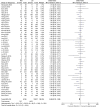Robotic Versus Laparoscopic Gastrectomy for Gastric Cancer: A Mega Meta-Analysis
- PMID: 35836604
- PMCID: PMC9273891
- DOI: 10.3389/fsurg.2022.895976
Robotic Versus Laparoscopic Gastrectomy for Gastric Cancer: A Mega Meta-Analysis
Abstract
Background: Laparoscopic gastrectomy and robotic gastrectomy are the most widely adopted treatment of choice for gastric cancer. To systematically assess the safety and effectiveness of robotic gastrectomy for gastric cancer, we carried out a systematic review and meta-analysis on short-term and long-term outcomes of robotic gastrectomy.
Methods: In order to find relevant studies on the efficacy and safety of robotic gastrectomy (RG) and laparoscopic gastrectomy (LG) in the treatment of gastric cancer, numerous medical databases including PubMed, Medline, Cochrane Library, Embase, Google Scholar, and China Journal Full-text Database (CNKI) were consulted, and Chinese and English studies on the efficacy and safety of RG and LG in the treatment of gastric cancer published from 2012 to 2022 were screened according to inclusion and exclusion criteria, and a meta-analysis was conducted using RevMan 5.4 software.
Results: The meta-analysis inlcuded 48 literatures, with 20,151 gastric cancer patients, including 6,175 in the RG group and 13,976 in the LG group, respectively. Results of our meta-analysis showed that RG group had prololonged operative time (WMD = 35.72, 95% CI = 28.59-42.86, P < 0.05) (RG: mean ± SD = 258.69 min ± 32.98; LG: mean ± SD = 221.85 min ± 31.18), reduced blood loss (WMD = -21.93, 95% CI = -28.94 to -14.91, P < 0.05) (RG: mean ± SD = 105.22 ml ± 62.79; LG: mean ± SD = 127.34 ml ± 79.62), higher number of harvested lymph nodes (WMD = 2.81, 95% CI = 1.99-3.63, P < 0.05) (RG: mean ± SD = 35.88 ± 4.14; LG: mean ± SD = 32.73 ± 4.67), time to first postoperative food intake shortened (WMD = -0.20, 95% CI = -0.29 to -0.10, P < 0.05) (RG: mean ± SD = 4.5 d ± 1.94; LG: mean ± SD = 4.7 d ± 1.54), and lower length of postoperative hospital stay (WMD = -0.54, 95% CI = -0.83 to -0.24, P < 0.05) (RG: mean ± SD = 8.91 d ± 6.13; LG: mean ± SD = 9.61 d ± 7.74) in comparison to the LG group. While the other variables, for example, time to first postoperative flatus, postoperative complications, proximal and distal mar gin, R 0 resection rate, mortality rate, conversion rate, and 3-year overall survival rate were all found to be statistically similar at P > 0.05.
Conclusions: In the treatment of gastric cancer, robotic gastrectomy is a safe and effective procedure that has both short- and long-term effects. To properly evaluate the advantages of robotic surgery in gastric cancer, more randomised controlled studies with rigorous research methodologies are needed.
Keywords: gastrectomy; gastric cancer; laparoscopic; meta-analysis; robotic.
Copyright © 2022 Baral, Arawker, Sun, Jiang, Wang, Wang, Ali and Wang.
Conflict of interest statement
The authors declare that the research was conducted in the absence of any commercial or financial relationships that could be construed as a potential conflict of interest.
Figures









References
-
- Chen K, Wu D, Pan Y, Cai JQ, Yan JF, Chen DW, et al. Totally laparoscopic gastrectomy using intracorporeally stapler or hand-sewn anastomosis for gastric cancer: a single-center experience of 478 consecutive cases and outcomes. World J Surg Oncol. (2016) 14:115. 10.1186/s12957-016-0868-7 - DOI - PMC - PubMed
Publication types
LinkOut - more resources
Full Text Sources

